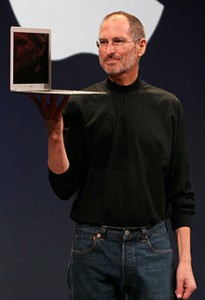



Dec
13
Sales of black mock turtlenecks, as worn by Steve Jobs at product launches, have gone through the roof. Has the death of the Apple co-founder prompted a surge in longing for geek chic clothing?
Since Steve Jobs’ family announced his death on Wednesday a steady flow of glowing tributes from the great and the good have flooded in. Big hitters including Barack Obama, Mark Zuckerberg and Bill Gates have lavished praise on the man widely considered to have been a true visionary and one of the greatest CEOs of his generation. Given Jobs undoubted influence over how we all live, it’s really little surprise his death has triggered such an outpouring of praise. However, what is somewhat more surprising is that his geeky fashion sense has seemingly come into vogue overnight.
Rise of the (mock black) turtleneck. Gossipy website TMZ reported that sales of black mock turtlenecks, as worn by Steve Jobs at product launches, have skyrocketed since his death. TMZ interviewed a rep for the St. Croix clothing brand (which kitted out Jobs) who revealed that they’d experienced an “almost 100% increase in sales” in the first 24 hours after his passing. The grateful rep added, “we have a great respect for everything he did and we’re glad he believed in our American-made product.”
Even before he died, Steve Jobs had secured his place in the pantheon of industrial design and as one of its most influential figures of the last century.
The Mac, the iPod and iPhone, born out of his vision of marrying high technology to an elegant and simple form, are already recognised by designers as among the most iconic products of the digital age.
Creations from the founder of Apple not only changed the way people communicate, watch films, listen to music and shop on the Internet but large Mac screens and graphics-friendly Mac software also make life easier for architects, publishers, artists and fashion designers.
“One of the truly great designers and mentors,” said British architect Norman Foster, known for working on major projects such as the Millennium Bridge in London, the Millau Viaduct in southern France and Swiss Re’s headquarters in London dubbed “The Gherkin.”
“Steve Jobs encouraged us to develop new ways of looking at design to reflect his unique ability to weave backwards and forwards between grand strategy and the minutiae of the tiniest of internal fittings,” Foster added.
The iPod, Apple’s big game-changer launched a decade ago, has a special place on the wall of fame of global consumer icons, alongside the Volkswagen Beetle, the Coca-Cola bottle, the Swiss Army pocket knife or the Olivetti portable typewriter.
Every country or culture can have its own consumer design icons — Italy’s Vespa motorscooter or America’s Cadillac — but only relatively few go truly global and endure.
Rarer still are those that change the way people do things.
“Steve Jobs has shown that breakthrough products come from taking intuitive risks, not from listening to focus groups. He was a master of semiotic design”, said British industrial designer James Dyson, best known for the dual-cyclone bagless vacuum cleaner.
From its inception in 2001, the iPod spread like electricity and reshaped the music industry in a way its predecessor, the Sony Walkman, failed to do in a lasting fashion.
Apple is a computer company yet it was the first to successfully commercialise digital music on the Internet well before industry giants EMI, Warner Music Group and Sony Music and helped save the industry from slow death by piracy.
Hundreds of millions of iPods have been sold, each featuring a simple retro dial that bears the hallmark of Jobs’ design philosophy of clean minimalism.
All over the world, iPods are tucked into the back of torn jeans and in the pockets of suits, strapped to the arms of joggers or entertaining commuters on tedious journeys home.
“Many credit Apple as probably the best advertisement for professional design and the role of design that we have ever seen,” said Brandon Gien, an executive member of the International Council of Societies of Industrial Design.
Then came the iPad, released in 2010, which changed the way people read newspapers and books, took notes, surfed the Internet, called each other on Skype and dealt with everyday practical problems thanks to hundreds of savvy applications.
At Paris Fashion Week, which ended on Wednesday, fashion buyers took photos of dresses with their iPad and once the show was over, they flicked through them as a catalogue they had just created and decided which ones they wanted to buy.


